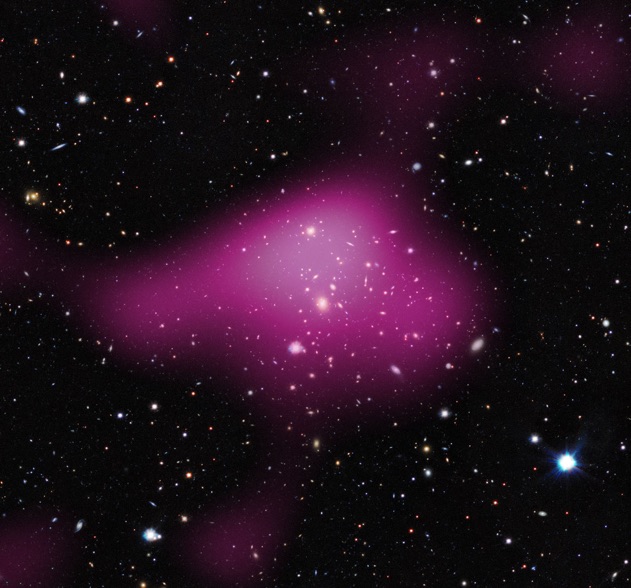Research

The gravitational field of massive objects in the Universe deflects light rays travelling towards us from distant galaxies. This deflection is accompanied by a distortion, which can be measured from high-resolution images of the sky. While a single galaxy might look unsuspicious one can detect these weak distortions by averaging over the images of many galaxies with appropriate statistical techniques. This yields, for example, a picture like the one above showing a mass reconstruction (in pink) of a massive galaxy cluster. This reconstruction was performed by measuring the shapes of thousands of faint background galaxy images. In this way, weak gravitational lensing can make dark matter visible!
Weak gravitational lensing

Imaging surveys
In order to measure weak gravitational lensing one needs large, high-resolution imaging surveys of the sky. Furthermore, one needs colour information to estimate the redshifts (and hence distances) of the tens of millions of galaxies detected in these images. By taking images in different colour bands one can estimate so-called photometric redshifts.
Most of the work in our research group is currently dedicated to the exploitation of the European Kilo Degree Survey (KiDS) and the Physics of the Accelerating Universe Survey (PAUS). In the future we will apply the same techniques to data from the ESA/NASA Euclid mission and the Large Synoptic Survey Telescope (LSST).
Results
In recent years, the analysis of KiDS has yielded some very interesting results that are presented in Hildebrandt et al. (2017) and Hildebrandt et al. (2018) and references therein. With weak gravitational lensing we measure the total matter density of the Universe as well as its clumpiness, two of the fundamental parameters describing our standard model of cosmology. Comparing the values found by KiDS with measurements from the Cosmic Microwave Background (CMB) satellite Planck we found a mild tension that is so far not understood. This tension might hint at a systematic error in one of the measurements or - more excitingly - at a breakdown of the standard model. Future data like Euclid and LSST on the one hand and better analysis techniques on the other hand will hopefully answer this most important question and shed some light on this mystery.
©Kilo-Degree Survey Collaboration/A. Tudorica & C. Heymans/ESO